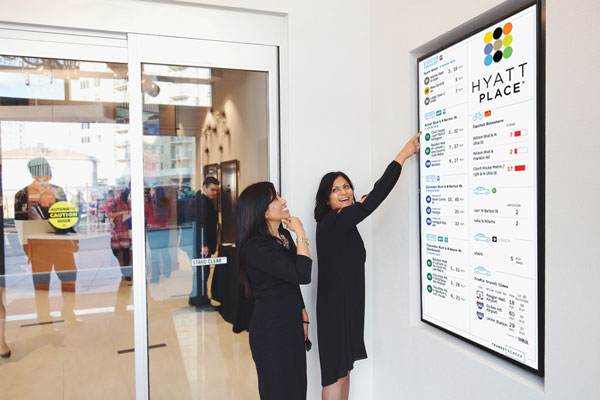Displaying Real-time Transit Information: An Update

Screens that provide real-time transit and other transportation information have become an amenity valued by office and residential tenants.
BY OFFERING OFFICE and apartment tenants real-time transit options right in the lobby on a big-screen monitor, building owners and managers are furnishing them with an amenity that they can repeatedly use to improve their scheduling, reduce commuting time and even relieve the stress of wondering when or if the next bus or train will arrive. A study by World Transit Research of Tampa, Florida, confirmed that when bus riders had real-time transit information, they cut their wait times by two minutes and greatly reduced their anxiety levels.
Since Development magazine first reported on this topic (see “Display Real-time Transit Information in Your Lobby,” Development, summer 2014), hundreds of robust new transit scheduling resources have been developed. Most of these are smartphone apps for iPhone and Android devices. Some of the more popular apps include Google Maps, Transit App, Moovit, Citymapper and Transit. Many transit agencies also offer their own real-time apps. Few of these apps, however, present all of the transportation options available at a given location.
While there is a lot of competition for transit information in the app space, there is little competition in the office and apartment lobby space. As noted in the earlier article, one company that is aggressively pursuing this market is Washington, D.C.-based TransitScreen. The firm was launched in 2013 following a civic technology project by Mobility Lab, an Arlington, Virginia-based organization that is funded by Arlington County Commuter Services, the U.S. Department of Transportation, the Virginia Department of Transportation and the Virginia Department of Rail and Public Transportation.
Two entrepreneurs working on the Mobility Lab project, Matt Caywood and Ryan Croft, saw a gaping hole in the daily commuting process and sought to fill it by delivering a product real estate owners and managers can use in their lobbies to give their tenants real-time travel information in just a few seconds, without using a smartphone.
Multiple Transportation Options
TransitScreen shows commuters the nearest transportation choices, including bus, train, ferry, bike-share, car-share (Enterprise, ZipCar, Car2Go, etc.) and ride-hailing (Uber, Lyft, etc.) services, as well as private shuttles, real-time automobile drive times and other local information, such as weather, date and time. Today, the company has 1,200 screens in operation in 33 cities, including many large U.S. cities as well as Toronto, London, Paris and Dublin. In less than three years, the number of TransitScreen employees has grown from three to 20. By the end of 2017, Croft expects TransitScreens to be in 10,000 locations in 10 countries and in 10 languages. Its employee headcount will likely double, from 20 to 40. The system is now being used by a diverse group of organizations, including LinkedIn, MakeOffices, Harvard University, Equity Residential, the National Institutes of Health, the cities of Seattle and Toronto, AvalonBay Communities Inc. and The JBG Companies.

Hotel guests at Hyatt Place hotel in Arlington, Virginia, view transportation options, including drive times. Photo courtesy of TransitScreen
In February 2017, TransitScreen announced a national partnership with JLL that will bring its displays to building lobbies throughout the U.S. “We are thrilled to partner with JLL to improve the transportation habits of their tenants and have a sustainable impact on the cities where we operate,” says Croft.
Karen Hollinger, a Washington, D.C.-area vice president of strategic initiatives for multifamily owner-operator AvalonBay, explains why the company includes TransitScreens at its projects: “In our lobbies, as well as through mobile access to our residents, we provide an efficient way for them to make travel plans. It is particularly important to provide [all transit options] for back-up planning (e.g., in cases of heavy traffic or for Metro down time). It also provides an avenue for our communities to post ad-hoc announcements or [promote] social events, serving an operational focus as well.”
According to Croft, one benefit of using TransitScreen is that offering this amenity requires only a large-screen monitor, access to the internet and a monthly subscription to the service. No dedicated, expensive hardware installations are required.
“We are a cloud-based software company,” says Croft. ”We pull real-time information from mass transit sources — the transit agencies that operate trains, buses, ferries and streetcars around cities as well as from the sharing economy — the bike-share systems, car-sharing [and car-hailing] systems like Uber, Enterprise Car Share. Recently, we added real-time highway traffic information, so that users know to avoid certain roads, with or without their cars.”
According to Avalon’s Hollinger, “Surprisingly, it has been equally important for our communities that are slightly removed from mass transit. These residents have [fewer transportation] options and it is even more important for them to ‘not miss that bus.’” As one example, she cites Avalon at Arlington Square in Arlington, Virginia, a large apartment community that isn’t near a Metrorail line but is served by several bus lines.
Hollinger expects such services to grow in importance. “We see a general year-over-year decline in cars owned at our communities, particularly in urban areas, and a corresponding increase in newer alternative options, including car sharing, bike sharing, Uber, etc. Soon, I suppose, we’ll have automated cars. This system is very helpful to provide a ‘one-stop shop’ for the hyperlocal options available to our residents,” she notes.
Why doesn’t TransitScreen have more competition in the real estate space? Croft says setting up this type of data feed is difficult and expensive. His company pulls data from 250 different sources each day. “Our screens update every 45 to 60 seconds. Every time it updates, we are pulling in that real-time information. There are 20 million data points we pull every single day and that would be difficult for anyone to duplicate.”
Ron Derven, contributing editor, Development




